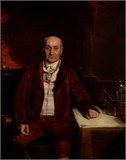Next to own the house and shop was a group of four people – two men and their wives; the Reverend Joseph White and Mary his wife and Mr James Sadler and Hannah his wife. The couples were connected because Mary and Hannah were sisters, neé Turner. It seems unlikely that either or both of the couples lived in the property, more likely that the purchase was an investment.
The Reverend Joseph White, born in Stroud in 1746, was a very well educated man. He gained his BA and MA degrees from Wadham College, Oxford and, in 1787, he became a Doctor of Divinity. He became Laudian Professor of Arabic from 1774, Bampton lecturer in 1781, Regius Professor of Hebrew and Canon of Christchurch, Oxford from 1802. But from 1788 until 1802, Joseph was a Prebendary at Gloucester Cathedral. He and Mary seem to have moved to Oxford in 1802 and stayed there until Mary died in 1811 and Joseph died in 1814. The couple do not seem to have had any children. The only two relatives mentioned by Joseph in his will are his two sisters, Hannah and Phoebe.

The second man involved in the transaction was James Sadler, seen above, described as an Esquire, of Gloucester. Very little is known about James but he was obviously a fairly important person in the life of the city and, in 1789, he became Mayor of Gloucester. In 1790, whilst living in the Precincts of Gloucester cathedral, he married Hannah Turner, sister of Mary Turner who was to marry Joseph White in Prestbury the following year. As with her sister and her husband, Hannah and James seem not to have had any children – only brothers, sisters, nephews and nieces were mentioned in James’ will. He was buried in Gloucester cathedral as befitted a man of his standing.
So, by the end of 1814, Hannah Sadler was the only one of the four still living. She moved away from Gloucester, settling in a Dorset village called Child Okeford, to be close to where her niece and her husband lived. Hannah died on 29th February 1828 and was buried in Gloucester Cathedral on 8th March 1828, presumably alongside her husband.
It appears that Charles Cooke continued to have an interest in the property until 1794 and, from then on, one John James Hough also was involved. I imagine they were the people who occupied the shop for their trade.
